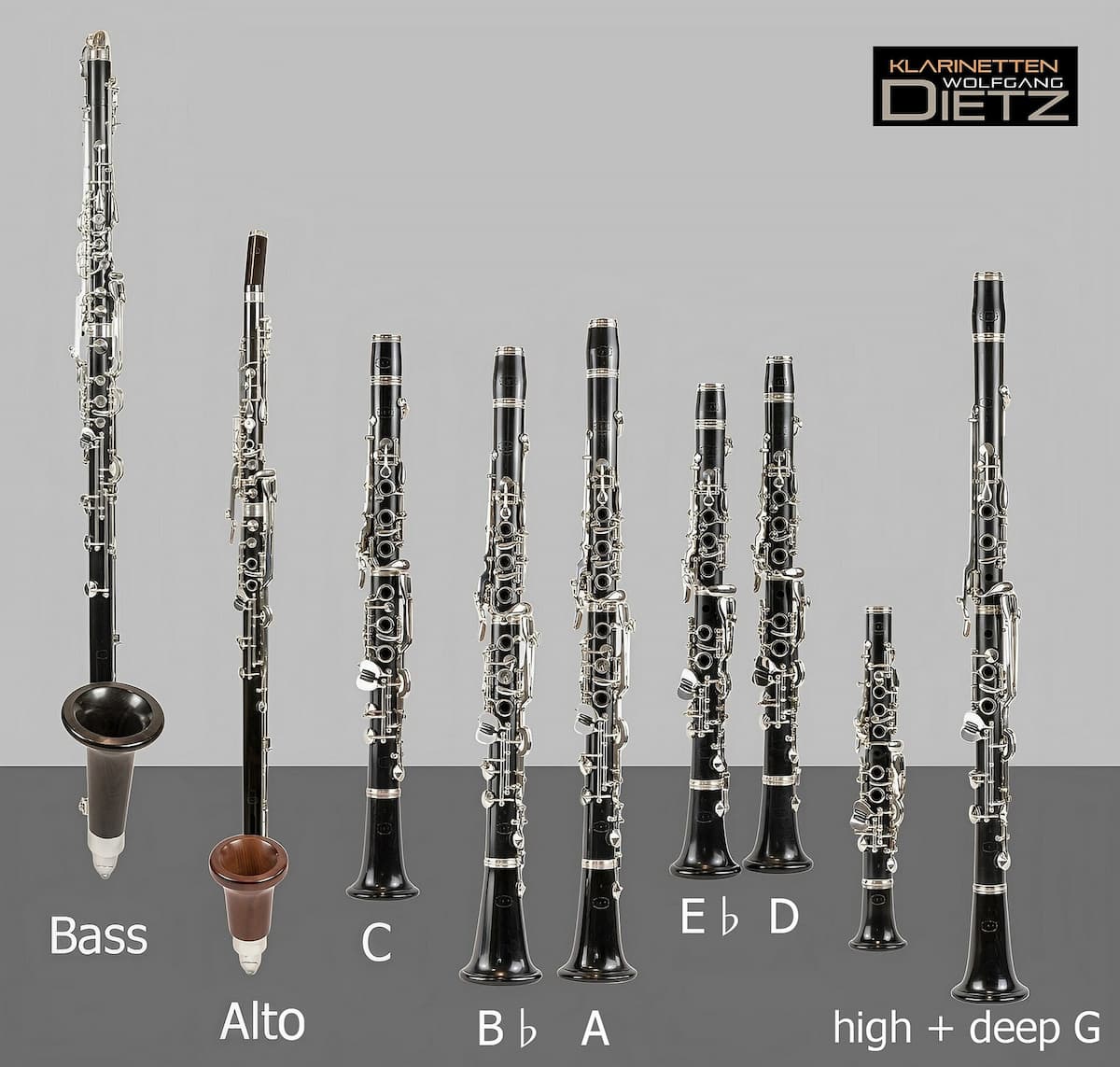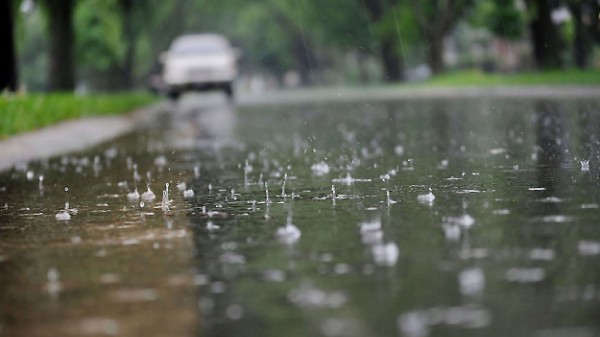The 20th century really fell in love with the clarinet. I always get goosebumps listening to the opening of Gershwin’s Rhapsody in Blue, with the clarinet sounding the delicious penetrating low trill followed by that long glissando. The technical demands on clarinettists increased dramatically in modern times, and a new generation of virtuosos inspired composers.

Rosewood Clarinets early 20th Century
We only need to think of the collaborations between Aage Oxenvad and Nielsen, Benny Goodman and Bartók, Hindemith, Poulenc and Copland, Frederick Thurston and Bliss, Gervase de Peyer and Musgrave, and Alan Hacker and Maxwell Davies.
Camille Saint-Saëns: Clarinet Sonata in E-flat Major, Op. 167
As we continue our survey of great clarinet music, let us listen to 10 fun and exciting, and sometimes intensely expressive Clarinet Sonatas from the 20th Century, starting with one of the last works by Camille Saint-Saëns.
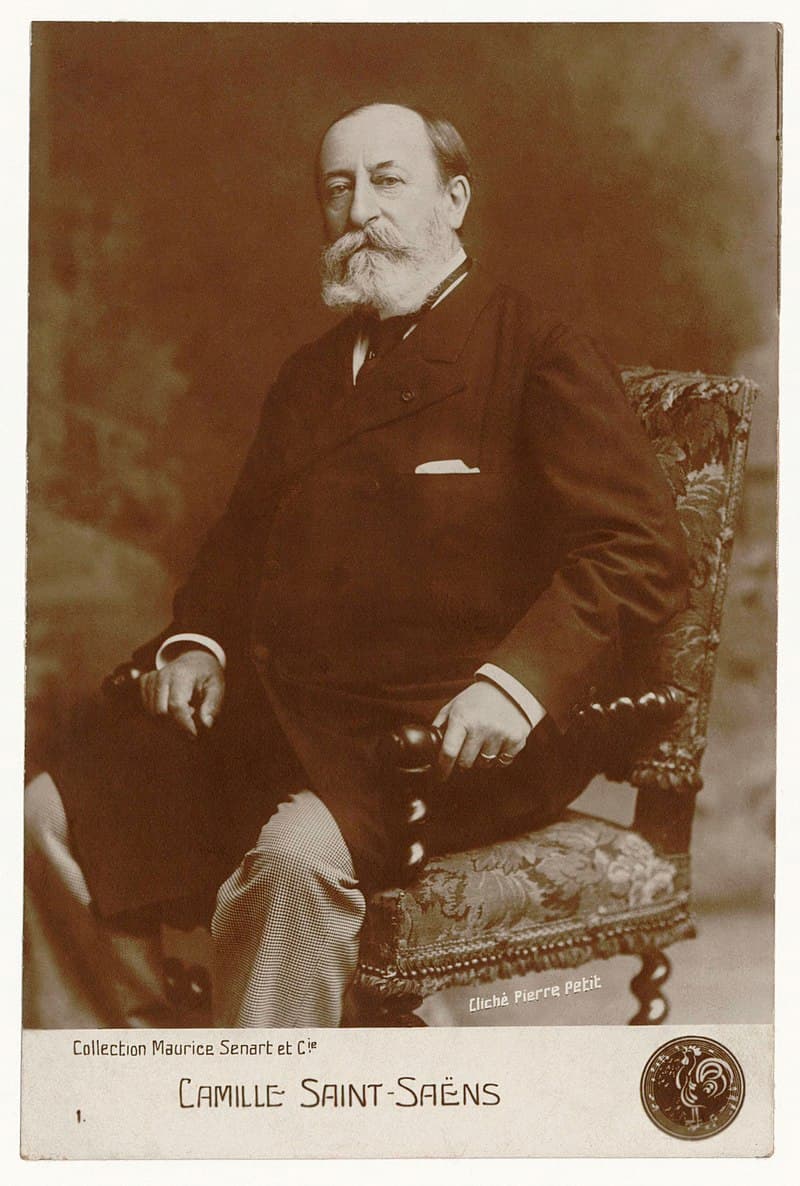
Camille Saint-Saëns in 1900
His Clarinet Sonata in Eb dates from 1921, the year of his death. It is a beautiful and gentle work, full of nostalgic, melancholy, and autumnal glow. As the composer wrote to a friend, “At the moment I am concentrating my last reserves on giving rarely considered instruments the chance to be heard.” Although composed in the first quarter of the 20th century, it clearly belongs to a time long past.
Darius Milhaud: Sonatina for clarinet and piano, Op. 100
Let’s stay in France for our next fun and exciting clarinet sonata, but this time the musical style is rather different. Darius Milhaud was already an international musical superstar in the mid-1920s, and his musical direction was almost exclusively influenced by the Latin-Mediterranean cultural milieu. I just love his outlook on music, as he followed no particular rules, or philosophy, or theory; he just loved to write music. And a lot of music he did write, almost 450 compositions in a substantial diversity of styles and techniques.
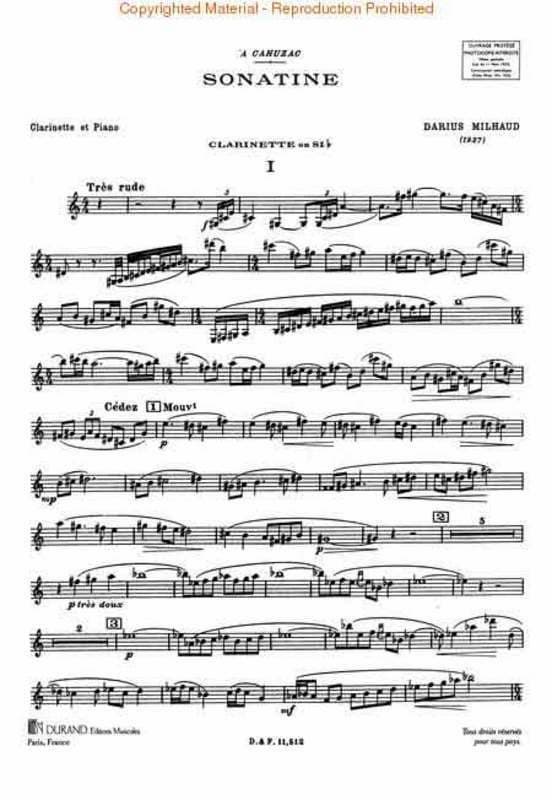
Darius Milhaud’s Clarinet Sonatina
When Milhaud composed his 100th opus, he did not write a great symphony or a lengthy ballet production but composed a modest Sonatina for clarinet and piano instead. Written during the summer of 1927, the work is dedicated to clarinettist Louis Cahuzac, who gave its premiere in 1929. This is no whimpering salon piece, however, but a really fun work that focuses on the playful treatment of the clarinet. There is polytonality, dissonant sonorities, and plenty of sophistication with just a touch of bluesy harmonies mixed in. How much more fun can you have with a clarinet?
Max Reger: Clarinet Sonata No. 1 in A-flat Major, Op. 49
Max Reger (1873-1916) was cut from an entirely different cloth, as he attempted to follow in the footsteps of J.S. Bach and Johannes Brahms. Reger called Brahms one of the “milestones of our music,” and he even sent him some early works for inspection. It is said that Brahms, uncharacteristically, responded with great cordiality and expressed interest in the young man’s compositions. On the other hand, critics of his music weren’t particularly nice and called it “a cult of ugliness for its own sake.”
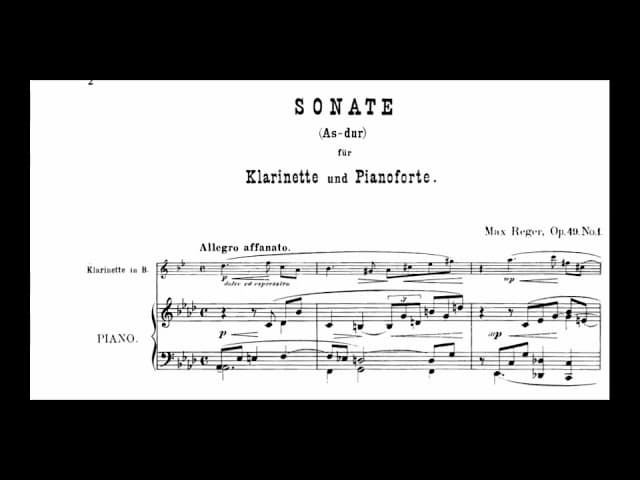
Max Reger: Clarinet Sonata No. 1
Being in love with the music of Brahms, it’s probably not surprising that Reger also turned his attention to the clarinet. In fact, he composed a total of 3 sonatas for that particular instrument. His first effort premiered on 18 April 1902, and to everybody’s surprise, even the critic liked it. The work was called “one of the best pieces Reger has ever written,” and everybody seemed delighted by the catchy and gracious second movement. “With its wonderfully sweet sostenuto episode, the creator of this work, which is full of longing, sang himself into everyone’s heart.”
Charles Villiers Stanford: Clarinet Sonata, Op. 129
Charles Villiers Stanford: Clarinet Sonata, Op. 129 (Murray Khouri, clarinet; John McCabe, piano)

Charles Villiers Stanford, c. 1894
Charles Villiers Stanford (1852-1924) is probably best known as a composer of Anglican church music. Together with Herbert Howells and Arthur Benjamin, Stanford taught composition at the Royal College of Music, and all three composed music for the clarinettists who studied or were professors at that school. Standford’s Sonata for Clarinet and Piano dates from 1911, and is dedicated to Charles Draper who taught Frederic Thurston. In turn
Thurston taught Gervase de Peyer, who gave the first performances of the Benjamin Valse-Caprices. As you can see, clarinet composition on the British Isles was a real family affair.
The sonata is scored in three movements, and according to experts “Stanford combines the clarinet and piano in exemplary style, his careful spacing of the clarinet and piano lines contrives to create an easy balance between the two instruments.” The opening “Allegro” movement is followed by a fantasy in ternary form entitled “Caoine.” This is actually an Irish lament, a modal monophonic song which contains a high degree of ornamentation and melodic variants. The concluding movement is a cheerful rondo, and Stanford’s other compositions for clarinet include a concerto, three intermezzi, and two fantasias for clarinet and string quartet.
Arnold Bax: Clarinet Sonata in D Major
Arnold Bax: Clarinet Sonata in D Major (Robert Plane, clarinet; Benjamin Frith, piano)

Arnold Bax, 1922
The Clarinet Sonata in D by Arnold Bax was first performed at a concert of the London Contemporary Music Centre at Cowdray Hall on 17th June 1935. For that performance, Frederick Thurston was accompanied by Harriet Cohen. Bax had actually composed an early work for the clarinet some thirty years earlier, but the mature work of 1934 is dedicated to Hugh Prew. He was an amateur clarinettist who played with Bax on the “Old Broughtonian Cricket Team,” which played village cricket in the west country.
The piano seems to play a dominant role in this two-movement work. A “Molto moderato” opener features the typical Baxian chromaticism and music rich in colour and warmth. The second movement is a brilliant “Vivace” that features fast passage work for both instruments before being contrasted with a yearning lyrical melody. Alternating between high energy and extended lyricism, Bax achieves a wonderful and fun sense of contrast and virtuosity.
Leonard Bernstein: Sonata for Clarinet and Piano
Did you know that the Sonata for Clarinet and Piano was the first published composition by Leonard Bernstein? He had met the clarinettist David Oppenheim during the summers of 1940 and 1941 while studying conducting with Serge Koussevitzky at Tanglewood. Initially, critics weren’t particularly impressed, and while the jazz inflections were considered a nice touch, the handling of the clarinet did not receive praise.
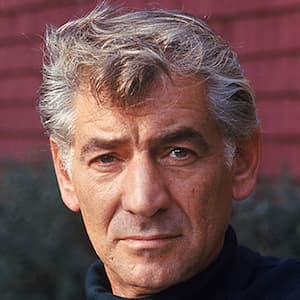
Leonard Bernstein
It took a bit of time, but today it is one of the most popular pieces in the clarinet repertoire. In fact, it is featured on the examination syllabus in England and Australia. The piece certainly reflects Bernstein’s youthful enthusiasm, like walking basses, pervasive syncopations, and melodic flourishes. When I promised you fun and exciting clarinet sonatas, this is certainly a piece I had in mind.
Paul Hindemith: Sonata for Clarinet and Piano
Paul Hindemith is one of the most influential German composers of the generation after Richard Strauss. In his early works, Hindemith experimented with a wide variety of new musical approaches and developed a highly individual tonal language. He rejected the experiments of the avant-garde and instead found a musical language sounding an expressive modernity. His works for clarinet, and he wrote a good many, are all based on a classically oriented aesthetic.
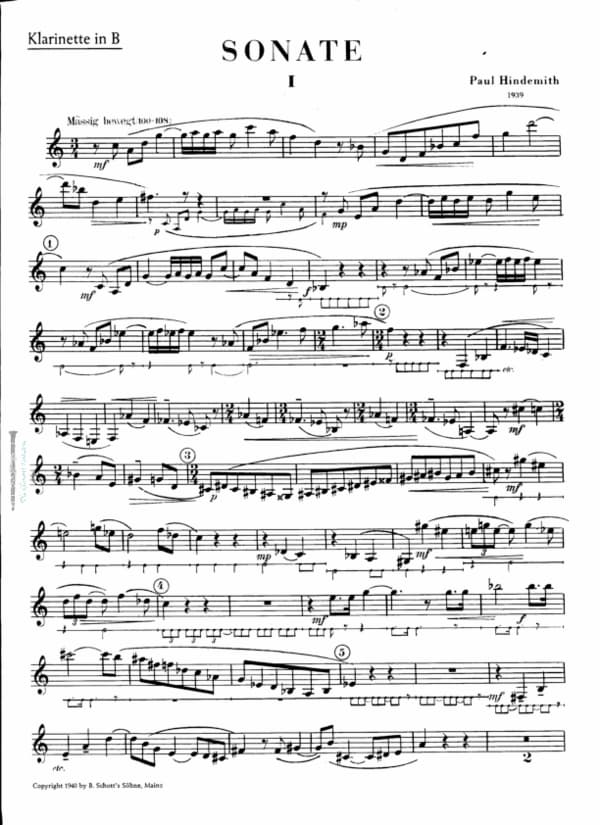
Hindemith’s Clarinet Sonata
The Clarinet Sonata dates from September 1939, and Hindemith paid special attention to the peculiarities and capabilities of the clarinet. Actually, he explored both the virtuoso and vocal-expressive possibilities together with different shadings and sound colours. It is a very transparent composition, written in a fun neoclassical spirit. The opening “Moderately” sets up some gentle confrontation, which always resolves into harmony and cooperation. A dance-like scherzo strongly contrasts with the movement titled “Very Slowly.” Here the clarinet is given a particularly striking opportunity to express a wide range of colour effects, and the cheerful “Little rondo” disappears into a very distant pianissimo.
Francis Poulenc: Clarinet Sonata
In 1962, the fabulous clarinettist Benny Goodman commissioned Francis Poulenc to compose a Sonata for Clarinet. The work is dedicated to the memory of Swiss composer Arthur Honegger, Poulenc’s friend and member of Les Six. Sadly, Poulenc died of a heart attack in Paris just a few months before the world premiere, which took place on 10 April 1963 at Carnegie Hall with Goodman and Leonard Bernstein as the pianist. The sonata became an immediate hit around the world, beloved for its enchanting vocal melodies, sparkling harmonies, and dazzling virtuoso passagework.

Benny Goodman, 1942
The opening “Allegro tristamente” is dramatic, self-consciously over-wrought, and sassy, with its own internal slow elegy. The “Romanza” is a gentle lament, marked très calme. The concluding “Allegro con fuoco” is bright and brittle, its circus-like energies yielding to one of Poulenc’s wistfully spun melodies, derived from the first movement. What a fun and exciting piece, and it’s no surprise that the work is loved by clarinettists around the world. Some composers and performers actually considered it the finest sonata for clarinet written in the modern era.
Sergei Prokofiev: Sonata in D major, Op. 94
During a relatively happy time in 1942, Sergei Prokofiev composed his Sonata for Flute and Piano, Op. 94, during his summer holiday in Alma Ata, Kazakhstan. Actually, the composer had drafted its themes before the war, inspired by the French flute player Georges Barrère. In the event, he put the finishing touches on the work in Moscow during the spring of 1943. It was premiered on 7 December 1943 by Nikolai Charkovsky and Sviatoslav Richter, and the famous violinist David Oistrakh immediately requested a version for violin and piano. Prokofiev quickly adapted his composition for violin, but made no further changes to the piano score. More recently, this wonderful Sonata was adapted once more, this time for a woodwind which seems particularly well suited; the clarinet.
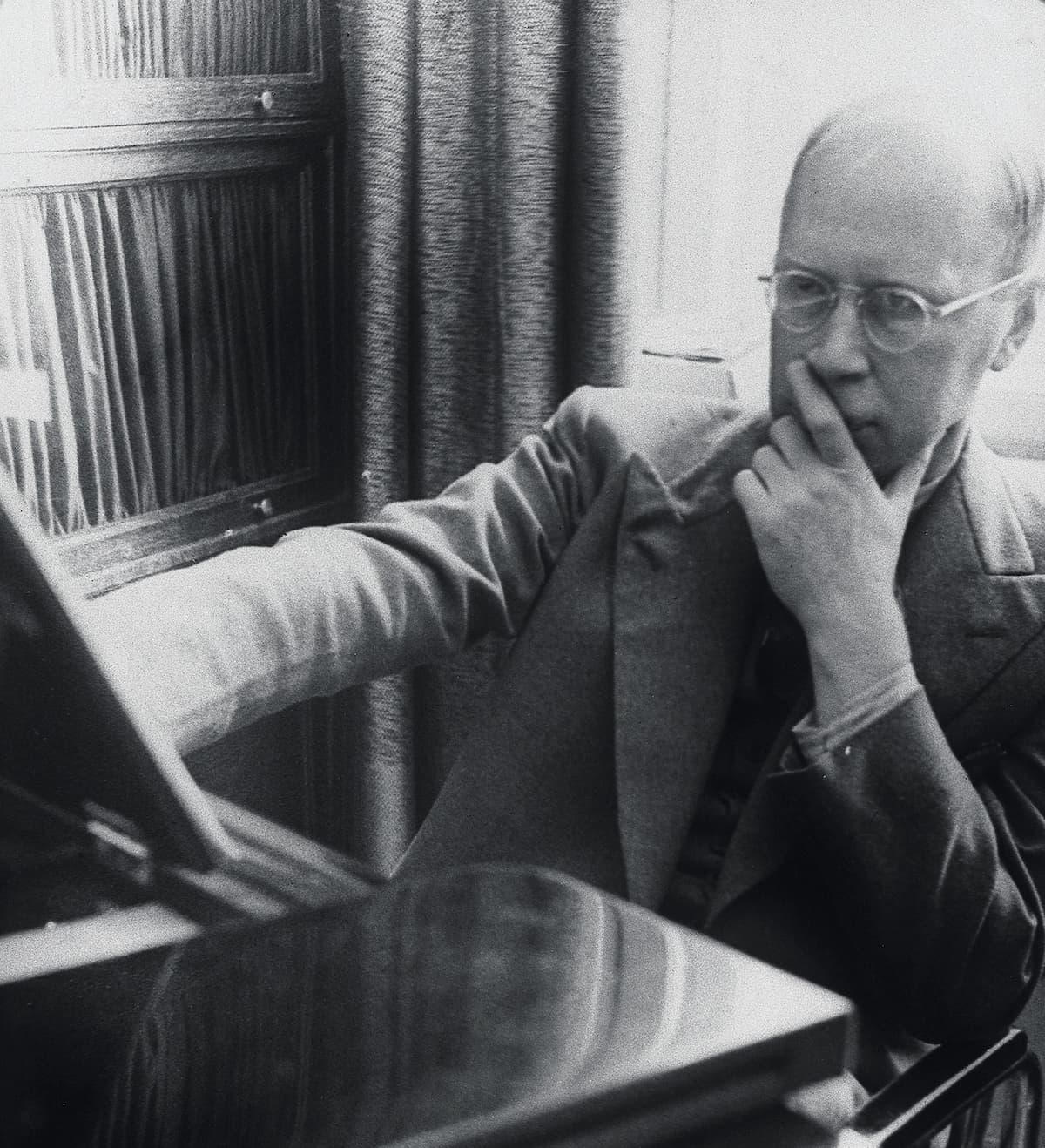
Sergei Prokofiev
The opening movement is painted with the neoclassical brush, while the second movement scherzo sounds light and capricious music in the clarinet. However, that sentiment is not shared by the piano at all, which strikes up a rather sardonic tone. The third movement contains a striking passage of jazz-inspired music, but the work ends in an upbeat finale. While it wasn’t a work specifically written for the clarinet, it sounds so well that it has become part of the standard clarinet repertoire. And I think it needs to be included in this blog.
Mieczysław Weinberg: Sonata for Clarinet and Piano, Op. 28
There are tons of sonatas for clarinet and piano written in the 20th century, but I want to conclude with the Sonata for Clarinet and Piano, Op. 28, by Mieczysław Weinberg. He was the son of Jewish parents of Moldavian origin, and he was highly active in the Yiddish theatres of Warsaw. He was very familiar with the clarinet from his youth, given its prominent place in klezmer bands and theatre ensembles. Weinberg wrote three works specifically for the instrument. In the Clarinet Concerto he allows the soloist to explore the clarinet’s extremes of register in virtuosic fashion, and his last completed work was the Chamber Symphony No. 4, featuring an obbligato clarinet.
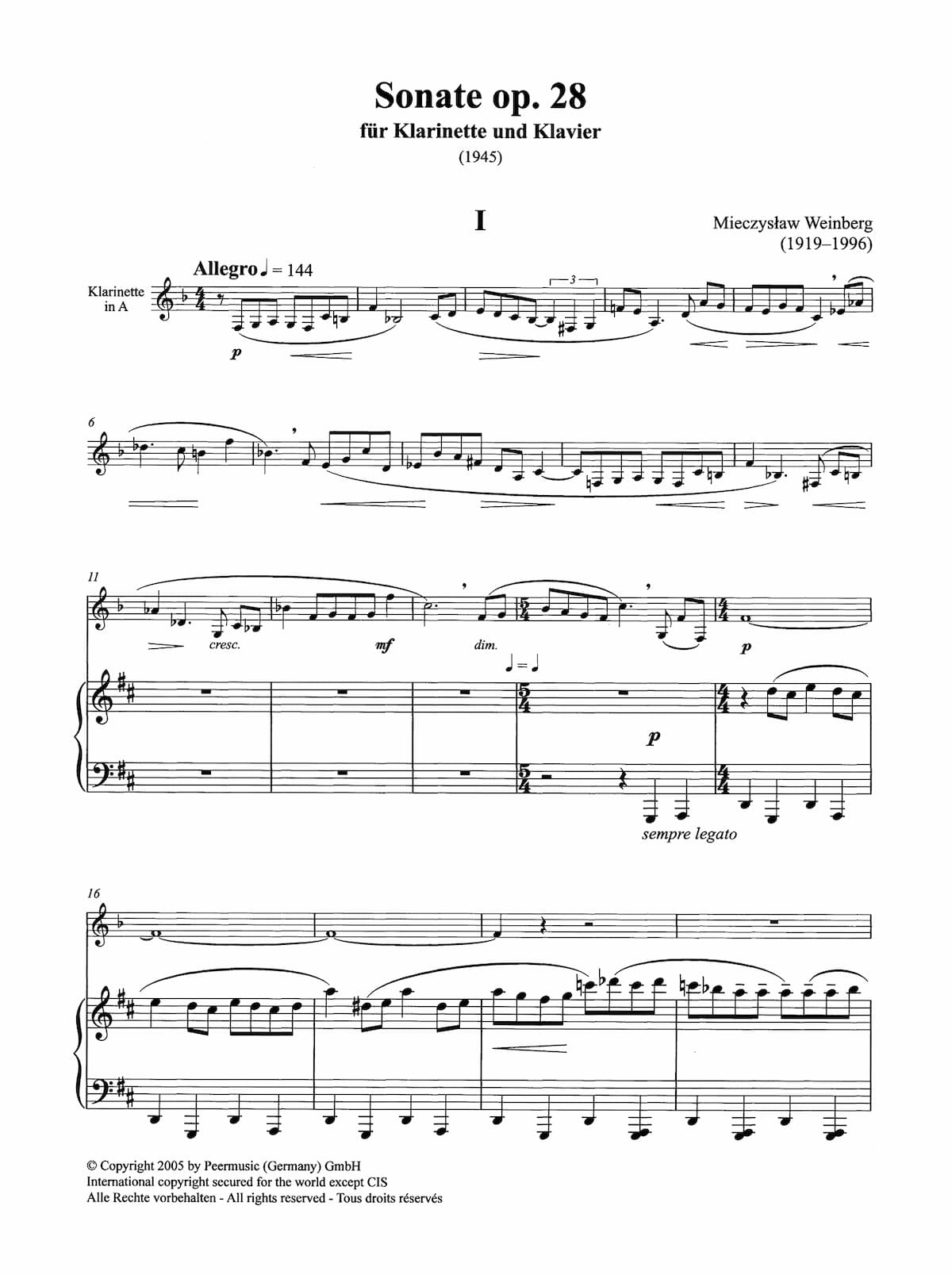
Mieczysław Weinberg’s Clarinet Sonata
Weinberg composed his Clarinet Sonata at the age of 26, and it has been described as “a work of great maturity.” Scored in three movements, it is a work steeped in Romantic and folkloric elements. The opening “Allegro” presents a vast sense of lyricism, but elements of Klezmer are quickly introduced. The piano and clarinet are equal partners throughout, and the concluding “Adagio” makes clear references to Jewish musical tradition. After the piano introduction, we hear a typical klezmer trill, and the clarinet enters with a long and improvised passage. A tragic melody, which has been compared to the Jewish prayer for the dead, brings the piece to a resigned conclusion. Composed during the horrible days of WWII it is clearly not a work of levity, but a highly original composition with an introverted and yet very intense sense of expression.
For more of the best in classical music, sign up for our E-Newsletter


